
An army, ground force or land force is a fighting force that fights primarily on land. In the broadest sense, it is the land-based military branch, service branch or armed service of a nation or country. It may also include aviation assets by possessing an army aviation component. Within a national military force, the word army may also mean a field army.

Jerry Eugene Pournelle was an American polymath: scientist in the area of operations research and human factors research, science fiction writer, essayist, journalist, and one of the first bloggers. In the 1960s and early 1970s, he worked in the aerospace industry, but eventually focused on his writing career. In an obituary in Gizmodo, he is described as "a tireless ambassador for the future."

Medieval warfare is the European warfare of the Middle Ages. Technological, cultural, and social developments had forced a severe transformation in the character of warfare from antiquity, changing military tactics and the role of cavalry and artillery. In terms of fortification, the Middle Ages saw the emergence of the castle in Europe, which then spread to the Holy Land.

A cataphract was a form of armored heavy cavalryman that originated in Persia and was fielded in ancient warfare throughout Eurasia and Northern Africa.
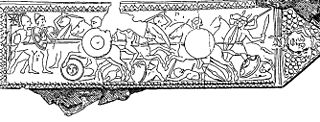
The Battle of Magnesia took place in either December 190 or January 189 BC. It was fought as part of the Roman–Seleucid War, pitting forces of the Roman Republic led by the consul Lucius Cornelius Scipio Asiaticus and the allied Kingdom of Pergamon under Eumenes II against a Seleucid army of Antiochus III the Great. The two armies initially camped north-east of Magnesia ad Sipylum in Asia Minor, attempting to provoke each other into a battle on favorable terrain for several days.

The Belisarius Series is a fictional saga in the alternate history and military history subgenres of science fiction, written by American authors David Drake and Eric Flint. Its protagonist is a real historical figure, the late Roman general Flavius Belisarius.
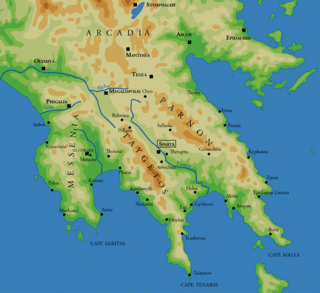
The Battle of Sellasia took place during the summer of 222 BC between Macedon and the Achaean League, led by Antigonus III Doson, and Sparta under the command of King Cleomenes III. The battle was fought at Sellasia on the northern frontier of Laconia and ended in a Macedonian-Achaean victory.

The Battle of Tigranocerta was fought on 6 October 69 BC between the forces of the Roman Republic and the army of the Kingdom of Armenia led by King Tigranes the Great. The Roman force, led by Consul Lucius Licinius Lucullus, defeated Tigranes, and as a result, captured Tigranes' capital city of Tigranocerta.

The Battle of Verneuil was a battle of the Hundred Years' War, fought on 17 August 1424 near Verneuil-sur-Avre in Normandy between an English army and a combined Franco-Scottish force, augmented by Milanese heavy cavalry. The battle was a significant English victory, and was described by them as a second Agincourt.

The Byzantine army evolved from that of the late Roman period taking as leading models and shaping itself on the late Hellenistic armies, but it became considerably more sophisticated in strategy, tactics and organization. The language of the army was still Latin, although later Greek dominated, as it became the official language of the entire empire. Unlike the Roman legions, its strength was in its cavalry, especially the armoured cataphracts, which evolved from the clibanarii of the late empire. Infantry were still used but mainly as a base of maneuver for the cavalry, as well as in specialized roles. Most of the foot-soldiers of the empire were the armoured skutatoi and later on, kontarioi, with the remainder being the light infantry and archers of the psiloi. The Byzantines valued intelligence and discipline in their soldiers far more than bravery or brawn. The "Ρωμαίοι στρατιώται" were a loyal force composed of citizens willing to fight to defend their homes and their state to the death, augmented by mercenaries. The training was very much like that of the legionaries, with the soldiers taught close combat techniques with their swords, spears and axes, along with the extensive practice of archery.

The Battle of Panium was fought in 200 BC near Paneas between Seleucid and Ptolemaic forces as part of the Fifth Syrian War. The Seleucids were led by Antiochus III the Great, while the Ptolemaic army was led by Scopas of Aetolia. The Seleucids achieved a complete victory, annihilating the Ptolemaic army and conquering the province of Coele-Syria. The Ptolemaic Kingdom never recovered from its defeat at Panium and ceased to be an independent great power. Antiochus secured his southern flank and began to concentrate on the looming conflict with the Roman Republic.

Heavy cavalry was a class of cavalry intended to deliver a battlefield charge and also to act as a tactical reserve; they are also often termed shock cavalry. Although their equipment differed greatly depending on the region and historical period, heavy cavalry were generally mounted on large powerful warhorses, wore body armor, and armed with either lances, swords, maces, flails (disputed), battle axes, or war hammers; their mounts may also have been protected by barding. They were distinct from light cavalry, who were intended for scouting, screening, and skirmishing.

For much of history, humans have used some form of cavalry for war and, as a result, cavalry tactics have evolved over time. Tactically, the main advantages of cavalry over infantry troops were greater mobility, a larger impact, and a higher position.
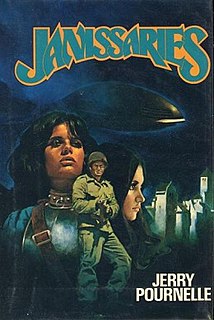
Janissaries is a science fiction novel by American author Jerry Pournelle. Originally published in 1979, and illustrated by comic artist Luis Bermejo, it is the first book of Pournelle's Janissaries series. The following books are Janissaries: Clan and Crown, Janissaries III: Storms of Victory and Janissaries IV: Mamelukes.
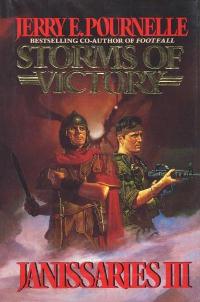
Janissaries III: Storms of Victory is a science fiction novel by American writers Jerry Pournelle and Roland J. Green, the third book of Pournelle's Janissaries series. It was originally published in 1987 and, unlike the first two books in the series, was not illustrated. In 1996 Janissaries III: Storms of Victory appeared in a double novel with the second book in the Janissaries series, Janissaries: Clan and Crown as Tran.
The Janissaries series of military and political-based science fiction novels are set in an interstellar confederation of races, in which humans are a slave race entrusted with military affairs and law enforcement. They were written by Jerry Pournelle, with Roland J. Green co-authoring the second two books.
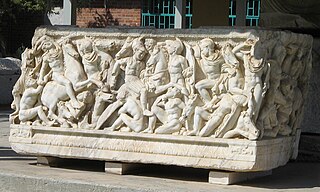
The Hellenistic armies is the term applied to the armies of the successor kingdoms of the Hellenistic period, which emerged after the death of Alexander the Great. After his death, Alexander's huge empire was torn between his successors, the Diadochi. During the Wars of the Diadochi, the Macedonian army, as developed by Alexander and Philip II, gradually adopted new units and tactics, further developing Macedonian warfare and improving on the tactics used in the Classical era. The armies of the Diadochi bear few differences from that of Alexander, but during the era of the Epigonoi, the differences were obvious, favoring numbers over quality and weight over maneuverability. The limited availability of Greek conscripts in the east led to an increasing dependence on mercenary forces, whereas in the west, Hellenistic armies were continuously involved in wars, which soon exhausted local manpower, paving the way for Roman supremacy. The major Hellenistic states were the Seleucid Empire, Ptolemaic Egypt and the Antigonid kingdom (Macedonia). Smaller states included: Attalid Pergamum, Pontus, Epirus, the Achaean League, the Aetolian League, Syracuse, and other states.
The Battle of Nisibis was fought in the summer of 217 between the armies of the Roman Empire under the newly ascended emperor Macrinus and the Parthian army of King Artabanus IV. It lasted for three days, and ended with a bloody Parthian victory, with both sides suffering large casualties. As a result of the battle, Macrinus was forced to seek peace, paying the Parthians a huge sum and abandoning the invasion of Mesopotamia that Caracalla had begun a year before.
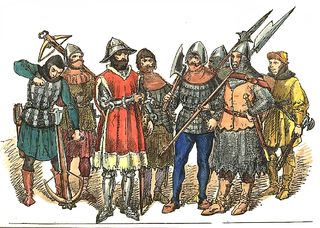
The Thirteen Years' War, also called the War of the Cities, was a conflict fought in 1454–1466 between the Prussian Confederation, allied with the Crown of the Kingdom of Poland, and the State of the Teutonic Order.
This is complete works by American fantasy writer Roland J. Green.

















